High pressure water pump: operating principle, types, rules for selection and operation
Residents of suburban villages whose territories are not connected to the central highways of water supply solve the issue of water supply by arranging autonomous systems. In the implementation of the task, a high-pressure water pump plays a key role. His main job is to stabilize the pressure in the system.
We will tell you what assortment of water pumps the market offers and by what criteria to choose equipment. We will introduce you to the leading manufacturers in the segment. Here you will learn about the design features of the technology that underlies the division into species.
For a clear perception of information, we supplemented the text with useful diagrams, collections of photos and video guides.
The content of the article:
Purpose and types of units
Regardless of where the water is taken from - from the nearest body of water, a specially equipped well, well, it can be automatically fed to the site using a conventional pump.
But for the normal operation of household appliances water pressure in the system must be at least 2.5 atmospheres and at the same time not exceed 6 atmospheres. And this parameter can only be achieved by installing a constant pressure maintenance system. For this purpose, use a variety of options for high pressure pumps for water.
When is a high pressure pump needed?
Enhancement and Support Instrument water pressure in an autonomous system used when the pressure is so low that it is not possible to use water for the operation of household appliances.
Installation of the pump is acceptable, but not particularly recommended for stabilizing the pressure parameters in the apartment circuit, if residents experience a real water shortage.
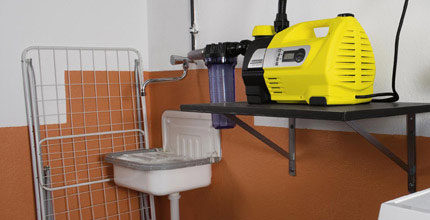
Using the device will be relevant if system pressure is not higher than 1 - 1.5 atmospheres. The small-sized device can be installed both on a common pipeline and on the outlet to a separate household unit. For example, by connecting to a pipe that supplies water to a boiler or washing machine.
In the first case, you will have to purchase a powerful device with good performance, in the second you can do with the installation of a small low-power automatic pump.
The functioning of the unit can be carried out by:
- Manual control - assumes continuous operation of the device, regardless of whether the water is currently being supplied, but provided that the device is turned off manually by force. They are used in the arrangement of "warm floors", where maintaining pressure in the heating circuits at the right level is required constantly.
- Auto mode - the device is switched on by an automation system, for example, when the crane is opened. The operation is regulated by a special flow sensor: at the moment of shutting off the tap, the pump stops functioning.
The main function of the adjustment system is to turn on the unit when the pressure drops and turn it off when it reaches the set parameter. After all, lowering the pressure in the line and its excessive increase destroys the pipe joints and has a detrimental effect on the operation of household appliances.
Alternative pressure boosting measures
However, installing a pump designed to stimulate pressure will be completely useless if the source has a low flow rate. It will not help, and if the system is blocked from time to time. The optimal solution in this situation will be the use of a self-priming pump station.
The pump station is equipped on the basis of the same category of pumps equipped with or without injectors. Besides supplemented by a hydraulic accumulatorintended for the supply of water. Outwardly, it looks like a regular tank, only a rubber membrane with air is laid inside. Manages a set of equipment and devices of a water pressure switch.
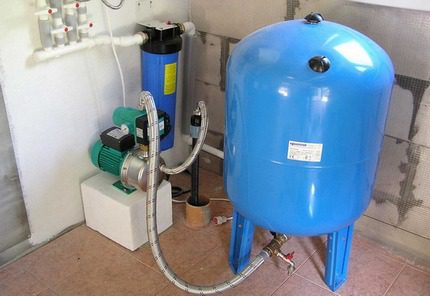
Installation of a self-priming pump station is also effective when the pressure in the basement of the house is normal, but it is not at all located above.
In the future, the accumulated water can be consumed regardless of whether water is present in the system, which is especially important in case of frequent interruptions in its supply. A significant drawback of such installations is the cumbersome design due to the presence of a hydraulic tank and the noise of the equipment during operation.
Instead of a hydraulic tank, you can use a conventional storage tank in which water will accumulate during the delivery period with a normal pressure.You can install it on a high flyover or on the roof of the house, and during interruptions use the reserve.
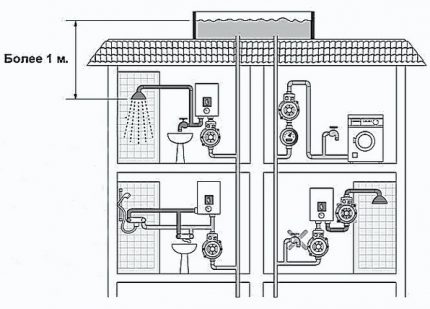
Types and action of high-pressure pumps
Before deciding to install a stimulating pumping device, the condition of the pipeline should be assessed. It is possible that the pressure deficit is due to pipes clogged by sediment. If you can get out of a predicament only by installing the device, then their technical specifics should be examined in more detail.
The principle of operation of high-pressure pumps, regardless of the type of working body and type of construction, is the same. The device in the process of functioning of the working unit creates a vacuum space inside the cavity, due to which water is absorbed.
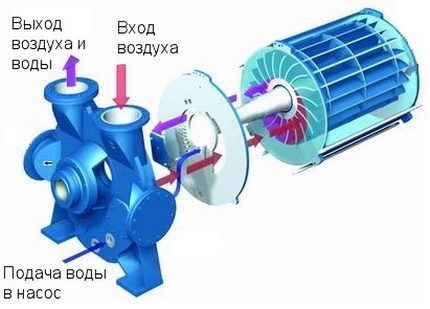
On sale are models of a universal type, suitable for water of any temperature, and those that can be used only in cold or only in hot environments.
There are two types of units depending on the cooling method of a running motor: with a dry rotor and with a wet rotor.
Dry Rotor Units
Modifications with a dry rotor are difficult to confuse with wet counterparts. They have an asymmetric shape with a clear advantage in the direction of the power part of the device. The fact is that its engine is equipped with a vane cooling device, because it is not washed in the course of work by water.
Due to the asymmetric shape and displacement of the axis towards the motor, the “dry” models are equipped with cantilever devices for additional fixation on the wall.

Due to the fact that the engine in such models is separated from the hydraulic part at the end of the axis by an oil seal, they serve much longer than “wet” ones. True, the sealant, like the rolling bearing, tends to wear out and needs to be replaced periodically.
For this reason, units equipped with a dry rotor require more frequent maintenance and regular lubrication of the rubbing parts. Another minus is that the “dry” devices are noisy, so the place for their installation should be carefully considered.
Wet Rotor Devices
Flowing units require cooling due to the pumped water. In this case, the rotor of the device is placed in an aqueous medium and is isolated by a waterproof flap from the stator.
Wet rotor units are notable for low noise emissions. Circulation pumps with a wet rotor are designed to equip heating systems, but are often used for water supply systems for heating residential premises.
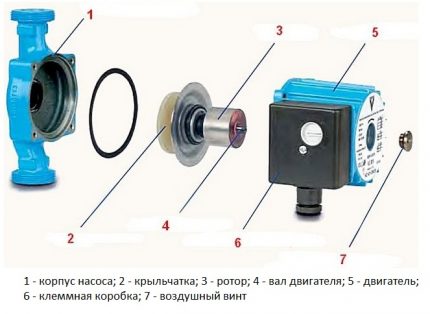
The plain bearings used in the assembly of the assembly do not require additional maintenance. However, “wet” pumps serve less and lose to “dry” units according to the parameters of the generated pressure. There are restrictions in the direction of installation - it is possible exclusively horizontally.
A significant drawback of this type of pump is its vulnerability when working with dirty water, the foreign inclusions of which can disable the device.
Division by the method of creating a vacuum chamber
The mechanism of operation of this type of device is based on the displacement reaction. The pumping process is carried out under the influence of resizing the working chamber. The magnitude of the resulting vacuum directly depends on the degree of tightness of the working chamber.
The amount of vacuum can be adjusted.Due to this, the pressure in some places of the system can increase, or, on the contrary, decrease.

The shaft is a leading working tool of the mechanism. The impeller equipped with blades carries out rotational movements. Under the action of the blades moving in a circle, the liquid located in the working chamber is captured. As it rotates, a centrifugal force is formed. It also leads to the formation of a liquid ring. The empty space formed inside the ring is a vacuum.
Depending on the methods by which a vacuum chamber is created, high-pressure pumps for water are centrifugal, vibrational and vortex.
Centrifugal Type Devices
Centrifugal pump pumps - the most common type of pumping devices that can provide high pressure in the system. They pump water due to the rotation of the impeller fixed inside the spiral-shaped casing. The impeller is two fastened discs, between which the blades are fixed in the direction opposite to the flow of the incoming fluid.
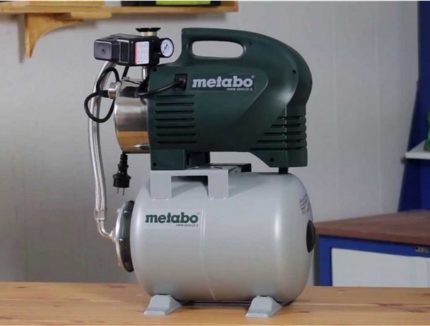
In the process of rotation, a centrifugal force is formed, which stimulates the displacement of water flows from the center of the chamber, folding it to distant sections. Due to this, the pressure level in the center of the rotating impeller is reduced, and water begins to flow into the inside of the housing.
Centrifugal devices in most versions are equipped with hydraulic accumulators. They are connected to pressure pipelines using pipes of different diameters.
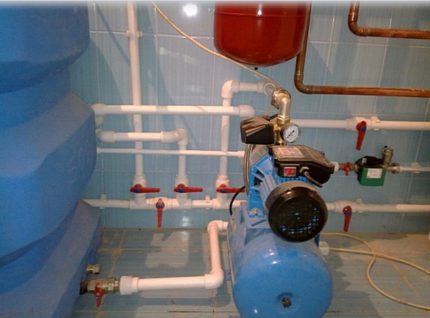
Centrifugal type equipment is able to provide uninterrupted water supply at high pressure. The only operating condition is that when the unit is started, it is necessary to fill the casing with water. The centrifugal variety has limitations: they cannot pump water from a depth of more than 8 m, but as a complement to the pressure boosting system from several pumps and reservoirs are quite suitable.
Vibration Electromagnetic Pumps
The principle of operation of vibration pumps is based on the ability of a magnet to alternately attract alternating current to itself, and then release the tandem anchor-piston. Changing the polarity of the armature makes alternating movements. Within one second, the position of the anchor can change several tens of times.
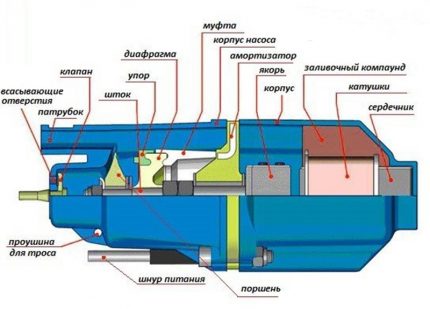
As a result of vibrational vibrations, water is first sucked into the working chamber, and then pushed through the valve into the discharge pipe.The vibrating unit can be paired with a centrifugal pump or pump a supply of water into a storage tank.
Vortex Pump Models
In the cavity of the housing of such units is a flat disk equipped with radially fixed blades. The rotation of the wheel with peripheral blades and creates a vacuum.
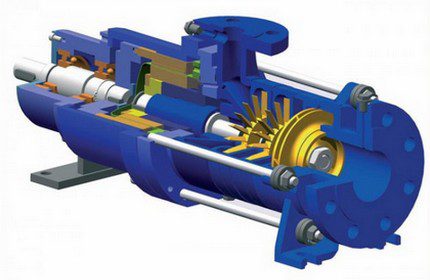
Vortex devices are famous for their high suction power. They are not afraid of the presence of air bubbles in the water. But they are vulnerable to the presence of suspended particles in a liquid and therefore have a limited scope. Since vortex devices quickly break down when pumping dirty water, they are not recommended for use in arranging sand wells and wells.
Leading manufacturers and popular models
Among the trusted global brands that are most popular, it is worth highlighting:
- "Grundfos" - The Danish company relies on pumps that have a circulating system of operation, which differ in small volumes.
- "CatPums" - A feature of equipment manufactured under this brand is the low pulsation of mechanisms at the highest pressure.
- "Wilo" - The German concern specializes in the production of small-sized pumping stations equipped with built-in hydraulic accumulators.
- "Sprut" - A feature of pumps to increase the pressure of this brand is the requirement for purity and temperature of water.
The manufacturers listed above produce their products according to proven technology that guarantees the reliability of pumping equipment. They are protected against overload, cycling and dry running.
The price range of low-power pump models varies between 30-50 cu More productive models equipped with an automation system can be purchased in the region of 70-100 cu Pumping stations will cost around 80-150 cu
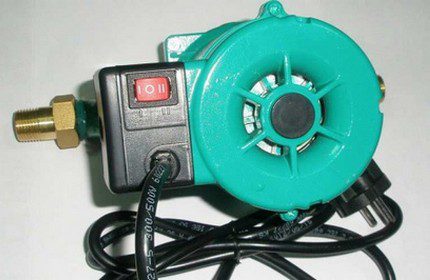
Among the models of the middle price segment, they have proven themselves well:
- "Sprut 15WBX-8" - a single design with a dry rotor has a capacity of 480 l / h with a power consumption of 90 watts. A small-sized small-sized device is placed directly on the pipe.
- Euroaqua 15WB-10 - the vortex electric unit easily copes with a liquid, which contains air or gas.
- Cristal 15GRS-10 - the model is famous for its low energy consumption and high efficiency, it is characterized by the ability to heat the water flow to an indicator of 65 degrees.
Do not save and buy Chinese fakes. Repair their masters are not taken. Unscrupulous manufacturers assemble them in such a way that failure of an individual element immediately leads to the need for a complete replacement of the unit.
Features of the choice of equipment
When choosing pressure pump It is worth focusing on a number of parameters.
Unit Performance Determination
This parameter depends on the task assigned to the pump and the required water flow. When calculating the total water consumption, household and household needs are taken into account, focusing on the total indicators of the maximum water consumption of all functioning consumption points for one temporary unit.
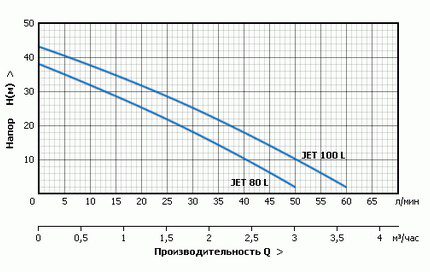
The performance of the pumps in the middle price segment is enough to raise the pressure by at least 1-1.5 atmospheres. If this is not enough, the system is supplemented by pressure boosting pumps or pressure stabilizing gears.
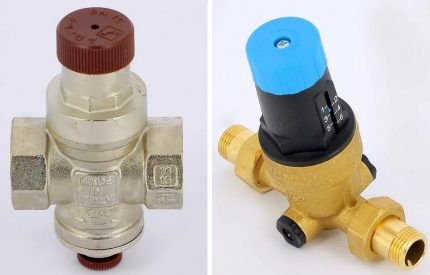
When choosing a unit, one should also take into account the moment that the productivity of the pumping device does not exceed the productivity of the well or well. Otherwise, with a quick emptying of the source and its untimely replenishment, the equipment will simply work “dry”. And this can lead to its breakdown.
Recommended head pressure
This parameter sets the height in meters to which the unit is able to lift water. When determining the required pressure, one should take into account the horizontal distance of the water supply and standard pressure losses during transportation through the pipeline.
If this parameter is calculated according to a simplified formula, then its value is taken equal to a tenth of the total length of the horizontal trunk. For example, a tenth of the length of a hose connected to the irrigation pump green spaces.
For example, when equipping a well with a depth of 10 meters to supply water to a house located 12 meters from the water intake, provided that it is placed at a height of 4 meters from the ground, the unit head is calculated by summing the values: 10 + 4 + (12:10) = 15.2 meters.
But in order to get more accurate calculations, one should also take into account the diameter of the pipeline and the pressure loss when lifting water through the pipes, as well as passing it through turns and nodes. After all, with insufficient pressure, the outlet pressure will be low. For this reason, when arranging water intake systems, pumps are selected that can maintain the pressure in the system within 2-6 bar.
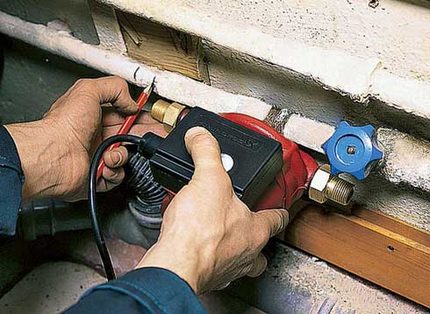
When choosing equipment, it is also worth considering:
- Operating temperature range;
- noise level created during operation.
Electric models and liquid fuel units are on sale. The first are powered only from the mains. They can be two- and three-phase. The second - are equipped with an internal combustion engine. They use diesel fuel or gasoline as fuel.
The presence of an automation system significantly increases the cost of equipment. But the high price of automated mechanisms with a high level of electrical protection pays off completely, since devices of this type respond more subtly to changing situations and consume less electricity.
Conclusions and useful video on the topic
Video review of the pump to increase pressure:
A variant of the arrangement of the system using a installation that increases the pressure of water:
The range of pumping equipment is presented on the market in a wide range. But experts recommend purchasing it in company stores. They will help you choose the best option, depending on the technical conditions of the facility and provide warranty service, which is especially important when buying expensive equipment.
Want to talk about how to choose a high pressure pump, or about the application of this type of equipment in practice. Please write in the comments box below. Here you can ask questions or report interesting facts.

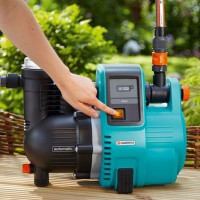 Self-priming pumps for water: types, principle of operation, recommendations for use
Self-priming pumps for water: types, principle of operation, recommendations for use 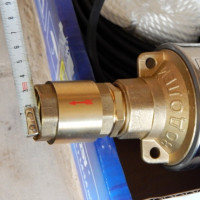 Check valve for the pump: device, types, principle of operation and installation details
Check valve for the pump: device, types, principle of operation and installation details 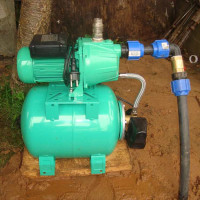 Ejector for a pumping station: operating principle, device, installation rules
Ejector for a pumping station: operating principle, device, installation rules  Overview of the water pump "Vometomet": device, types, decoding of markings and specifics of operation
Overview of the water pump "Vometomet": device, types, decoding of markings and specifics of operation  Pumps to increase water pressure: types, how to choose, installation technology + wiring diagrams
Pumps to increase water pressure: types, how to choose, installation technology + wiring diagrams 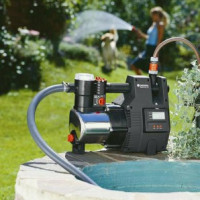 Installation of a surface pump for a cottage: rules for connection and operation
Installation of a surface pump for a cottage: rules for connection and operation  How much does it cost to connect gas to a private house: the price of organizing gas supply
How much does it cost to connect gas to a private house: the price of organizing gas supply  The best washing machines with dryer: model rating and customer tips
The best washing machines with dryer: model rating and customer tips  What is the color temperature of light and the nuances of choosing the temperature of the lamps to suit your needs
What is the color temperature of light and the nuances of choosing the temperature of the lamps to suit your needs  Replacement of a geyser in an apartment: replacement paperwork + basic norms and requirements
Replacement of a geyser in an apartment: replacement paperwork + basic norms and requirements
Here the construction of my new house is coming to an end. And it's time to decide on the choice of pump. As I understand it, I need a submersible type water pump. At the moment, I settled on the choice of a vibration model, I think it is perfect for me. More information about the installation itself. But in general, I do not really need it, because the master will install it. And I don’t really understand this. In general, the information is very useful and interesting. Good luck.
How realistic is it to install such a pump in an apartment? We have cold water pressure from 0.5 to 0.8, not more. First of all, the legality of the connection is of interest.
Hello. If the pressure problem is due to narrowing of pipes or clogging with rust / dirt, the pump will not help.
Art. 25-29 of chapter 4 of the RF Housing Code (reorganization and redevelopment of residential premises) - here, in my opinion, these articles govern such actions as the reorganization of the engineering system, which may entail a deterioration in the operation of the entire house system.
In general, according to the standards, your pressure is very low, of course - it does not fit into any norm. You should write a statement to the Criminal Code and demand that everything be fixed. And so, it is possible at a general meeting to resolve the issue of installing an accumulating tank with a pump on the riser, if the problem is not in the pipes.